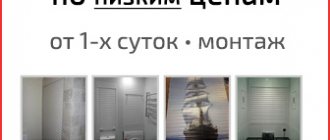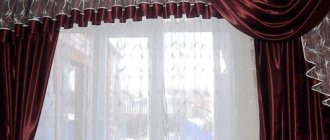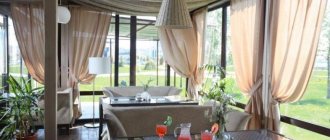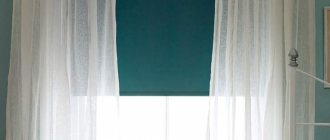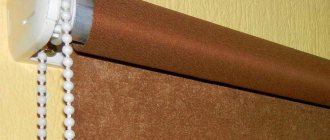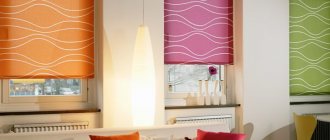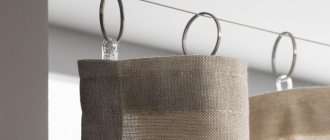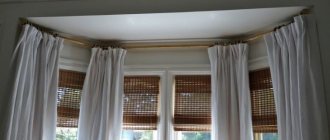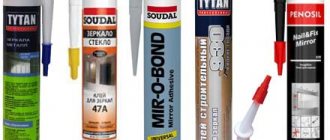The interior will be harmonious provided that it is thought out to the smallest detail. When it comes to creating the interior of a residential building, one of the main components of an attractive design is the design of window openings. The role of curtains is difficult to overestimate. They emphasize the style of the house, protect from prying eyes and sunlight. But not all curtain elements can always fit harmoniously into the design. Most often, difficulties arise with the cornice. Often you want to hide it, make it invisible. In this case, you need to use a hidden curtain rod. It will make the functional part of the design invisible, hide some of the imperfections of the walls, and make it possible to focus all attention on the beautiful, bright curtains. How to make and install a hidden ceiling curtain rod is described in more detail in this publication.
Interior aesthetics sometimes imply the absence of unnecessary details
When the cornice is not visible, all attention is paid to the beauty of the curtains
Brief description of the design, advantages
The cornice is usually closed with a special niche. Its arrangement and design features must be planned in advance - even at the stage of finishing the ceiling. In a niche you can hide all the unwanted functional parts of the curtain, install lighting, and create the effect of a floating curtain.
The niche space does not require special finishing; it will still be hidden by curtains
For hidden fastening of curtains, a cornice of any convenient design is suitable
Note! If you do not provide a niche in advance, in the future you will have to dismantle part of the decoration, change the tension structure, or come up with a decorative element to hide the suspension.
The dimensions of the niche depend on the structure that needs to be placed in it
When should it be used?
When do you need to place curtains behind the ceiling plinth, in a special niche? There are two objective reasons for this.
- Functional necessity. This need arises in rooms with a stretched ceiling. It is forbidden to mount rigid structures on the surface of the film; wall-mounted cornice options are also not suitable for all. The easiest way is to provide a special niche at the installation stage. Its dimensions are determined individually.
The threads of this curtain seem to flow from the stretch ceiling; you cannot achieve this effect with an open cornice. - Interior preferences. Standard cornices have long lost their popularity. They are difficult to fit into modern interior styles. Today it is fashionable to decorate windows with airy curtains flowing from the ceiling. This effective design technique is especially relevant for minimalism, modern, and loft styles.
If the cornice does not match the style of the space, you can simply hide it
Conclusion
Wenge or polyurethane ceiling plinth makes it possible to complete the intended design of the room. Whatever material you provide, it should be combined with the overall style of the room and emphasize it. You can also make a special niche for a curtain rod from plasterboard, which will not be difficult to disguise with a plinth.
The video in this article will provide an opportunity to expand your knowledge on this topic. If you have any questions while reading the publication and after it, please ask them in the comments, we will be happy to answer them.
Advantages
The most important advantage is aesthetics. The photos in our article will give everyone the opportunity to see how attractive and unusual a floating curtain looks. Closed pendants mask unattractive parts of the wall, visually adjust the height of the ceiling, and make it possible to decorate the design with light lighting.
Hidden fastening of curtains is appropriate in rooms with low ceilings
Possibility to adjust the distance from the window. Some apartments have wide window sills. In this case, the wall mounting option for curtains is absolutely not suitable. You can place the fabric on the ceiling at any distance from the opening - for any width of the window sill.
Fixing the curtains in a niche eliminates the problem of choosing the design of the cornice and accessories
Focusing on decor. Less than attractive fasteners will not distract from the beautifully flowing fabric. Even the lighting installed in a niche will not attract much attention. They will only slightly emphasize the textile composition.
Using lighting you can easily create a unique atmosphere in your bedroom
Thick curtains covering the entire wall will make a narrow room visually wider
Recommendations for equipment and installation of niches in suspended ceilings
The first thing you need to pay attention to when planning the installation of hidden curtain rods is what type of curtain will be used in the future. Both light materials (tulle, gauze, chiffon and satin) and heavy fabrics (gabardine, lurex, velor and velvet) are equally suitable for stretch ceilings.
Accordingly, for each type of curtains, a different type of frame is selected - a plastic or metal profile, a pipe or multi-row pencil cases. To implement the practical part, try to take into account the following aspects:
- Curtains for suspended ceilings look best in large and deep niches that can be equipped in tension systems. Typically, this design option is used in large and spacious rooms, where there are no critical comments on the height of the room and the area of the ceiling.
- The width of the niche varies in the range of 10-25 cm, depending on what type of fabric is used for the curtain and how many rows there will be.
- Do not forget to take into account the width of the window sill when determining the width of the niche. Together with heating radiators, the window sill usually protrudes 10 mm from the wall. Curtains should not lie close to radiators.
- It is better to make a niche across the entire width of the room, this will make it easier to install a suspended ceiling and this design will be convenient for installing and dismantling cornices.
Options for hidden ceiling cornices
There are two masking options:
- in a special niche;
- camouflage using baguette structures.
The first option involves constructing a recess in a suspended ceiling or in a plasterboard ceiling. The optimal niche for curtains will have individual dimensions. They depend on several criteria: the width of the window sill, the features of the curtains, the dimensions of the suspension itself (it can have several stripes). The depth of the trench is usually standard - from four to fifteen centimeters. The depth will depend on the features of the ceiling structure.
A niche can be provided when installing a suspended ceiling
You can also make a separate structure that covers only the cornice itself.
If you do not want to install curtains, you can resort to the standard mounting method - wall-mounted. At the same time, the unsightly suspension is masked with decorative baguettes. Decorative overlays can cover fasteners, decorate the interior, and do not require effort for installation. This design method is relevant for classic designs.
Niche for curtains in a suspended ceiling: design options and fastening methods
When creating an original interior in your apartment or house, you can’t help but pay attention to suspended ceilings. It is through this type of ceiling design that the necessary style and image of the living space is created. Modern technologies have stepped forward, opening up almost unlimited possibilities for the designer’s imagination. If previously it was quite difficult to select cornices for a stretch ceiling, today the situation has changed radically.
Technologies and consumables have appeared that make it possible to equip a room with tension systems with beautiful and stylish curtains. For these purposes, curtains for curtains under suspended ceilings are used, which have different designs and differ in installation methods. Hidden cornices look the most attractive, the installation and design of which arouse genuine interest. Let's look into it in detail. What is needed to properly and correctly install hidden cornices for a tension system.
Making a hidden suspension yourself
The easiest way to cover the cornice is to make a trench from plasterboard. To do this, you need to know in advance the features of the curtains, the length, width of the curtain rod.
Calculation of niche width
You should also prepare some tools and materials:
- construction tape;
- sheet of drywall;
- long metal ruler;
- knife with replaceable blades;
- roughing plane;
- ceiling, guide profiles;
- screwdriver;
- self-tapping screws
First you need to prepare the drywall. We cut it into strips of the required size - from four to fifteen centimeters. We cut drywall using a knife.
Having made the blanks, you can begin installing the ceiling guide profiles. From these you need to build a metal niche frame. The profiles are attached according to the markings. It can be applied to the ceiling with a regular pencil or paint cord. When fastening, we adhere to one rule - the dowel spacing is at least 60 centimeters.
First, the first profile is installed strictly according to the markings
Then a frame of short jumpers and a lower profile is mounted
Then we form the sides of the box. To do this, we use prepared plasterboard sheets. We fasten the sheets in increments of at least fifteen centimeters. Then we mount the end sides in a similar way. We process them with a plane. At the end, the bottom of the box is sewn up.
The box is ready for putty, which is done with a reinforcing mesh
After this, you can start designing the decorative component. The box can be puttied, painted, or wallpapered.
After completing the dirty work, you can fix the cornice
Choosing a cornice
The choice of hidden curtain rods usually involves selecting a design based on three main criteria: the weight of the curtains, the length of the window opening, and the number of strips. Also, when choosing, you should take into account the material from which the suspension will be made.
First you need to decide on the design of the curtains, and then choose a cornice
A separate niche above each window is a labor-intensive solution, but very original.
Types of materials and brief characteristics of cornices are discussed in the table:
| Type of cornice according to the material used | a brief description of |
| Wood | Suitable for absolutely any room. They harmonize especially well with classic, Provence, and country styles. Most often, wooden models are installed in children's bedrooms. These rooms always have high environmental requirements. Wooden hangers can withstand high loads. |
| Plastic | Modern plastic does not turn yellow for a long time, is environmentally friendly, and durable. Affordable price is another important advantage. Plastic models are usually chosen for light curtains. |
| Metal | They are distinguished by a variety of designs, high strength, and can withstand enormous loads. Ideal for hanging heavy, multi-layer curtains. |
| String | Ideal for light, airy tulles. They are a metal string. The design of the cornice is as simple as possible and can last a long time. The main condition is not to hang heavy curtains on the strings. Due to the high load, the string will begin to bend over time. |
The most commonly used option is a plastic profile rail, which can be hidden in a niche just a few centimeters deep.
Element name and properties
The finishing industry strives to continually surprise its consumers by offering a wide variety of products.
She also paid attention to the plinth on the ceiling, which is often called:
The products are convenient, quick to use and very often their price is quite low. Thanks to them, it is possible to add the final accent to the interior of any room.
Their following qualities should be highlighted:
- practicality in manufacturing;
- light weight, often even weightless;
- various geometric dimensions, so with their help you can increase or decrease the visual dimensions of the room, as well as hide defects of the main surfaces;
- the installation rules are simple, so installation is usually done independently, without the involvement of finishing craftsmen;
- the cost of products is low, unless we are talking about solid wood or exclusive elements made to order.
Let's look at the main materials in order of popularity:
Can be mounted on any type of ceiling covering using adhesive or putty.
- good performance characteristics;
- aesthetic properties correspond;
- easy to process, install and remove;
- resistant to deformation;
- long period of use;
- paints well;
- does not rot and does not spread mold;
- hygroscopic;
- cannot be visually distinguished from gypsum stucco;
- a wide range of shapes and sizes;
- inexpensive.
- brittle;
- supports combustion;
- releases toxic substances at high temperatures.
- They produce a baguette from foam plastic, thanks to which it is possible to create not only light, but also quite durable structures;
- The material is harmless to our body, so it can be placed in residential areas. It is also not afraid of changes in temperature and humidity, does not deform for a long time, and is resistant to mechanical stress;
- Successfully replaces stucco, which has become a real gift for interior designers;
- Polyurethane baguette can be painted in the chosen color, increasing the effectiveness of the decor;
- Available in two versions - rigid and flexible. In the latter case, you can install the fillet even on uneven and non-standard surfaces; it will hide almost all defects;
- When choosing, you need to consider:
- · color and structure of ceiling and wall surfaces;
- · lighting fixtures in the room;
- The required amount of plinth for installation is determined by the perimeter of the room. In this case, it is advisable to make a reserve of approximately 10% for trimming;
- Special glue or acrylic putty is used as a fastening compound.
Economy class baguettes, there are options specifically designed for the installation of plastic lining. Install the element on mounting brackets or fix it with self-tapping screws.
Fillets are produced in different sizes and colors. The products are not afraid of moisture, but are not resistant to temperature changes, support combustion, are fragile, and cannot be painted.
Plaster stucco molding
- Classic version;
- The basis is the natural material gypsum;
- Parts are made manually and individually;
- Allows you to create an exclusive ornament in the room, thanks to its plastic properties;
- It is perceived as an artistic ornament.
Rarely used due to their heavy weight and fragility, which especially affects during installation. The parts are attached to gypsum mixtures or gypsum, and alabaster is also used.
- The material is classified as a classic version;
- You can find products made from construction and exotic wood, which is much more expensive;
- They are in demand as an independent decorative element;
- A wooden plinth looks good in an attic or log house, as well as a bathhouse;
- The building material is environmentally friendly and is not difficult to install and operate. Resistant to mechanical damage;
- Requires treatment with fire retardants and antiseptics, may fade in the sun;
- Does not differ in plasticity.
How to hide hangers with a ceiling plinth: photos, examples
You can cover some shortcomings in wall decoration and hide the suspension using a regular ceiling plinth. However, this requires basic skills in installing skirting boards on the ceiling. First you need to choose the baseboard itself. It should be wide and have a flat surface on top so that it can be fixed to the ceiling.
If the curtains are suspended from a ceiling cornice, it is quite easy to create the illusion of a hidden cornice using an ordinary baseboard
Products made from polyurethane foam, polystyrene foam or duropolymer are suitable for this purpose.
Note! Ceiling plinth plays an important decorative role in the interior. Its design, color, and ornament must be in harmony with the overall style of the room.
In order for the baseboard to hold securely, you will need to install a vertical base in the form of a plank.
The design must completely hide the curtain fastening elements
Next, you should purchase glue for attaching polyurethane products. It must be applied to the baseboard and the canvas pressed tightly against the ceiling. The glue sets quickly enough to securely fix the product. The plinth is attached at a short distance from the cornice. The same skirting boards should be placed around the entire perimeter of the room. Then its design will look solid and harmonious.
You can see photo examples of such methods of masking suspensions below.
What you need for work
Since we will be considering a reliable and thorough version of the work, we need to prepare for it accordingly. The following components are needed:
| Cornice | You still can’t do without it; the simplest option without cladding and decorative elements will suit you; its price will be low. It is important that the product is of high quality and reliable, especially if you use heavy curtains |
| Metallic profile | The frame will be constructed from it, so you need to have the required number of elements at hand. Most often, two main and two wall profiles are enough, but it is better to take measurements to calculate everything correctly |
| Drywall | The constructed box will be sewn up with this material; most often, an inexpensive option with a thickness of 9 mm is used, which perfectly performs the assigned tasks and weighs much less than elements with a large thickness |
| Skirting | It should also initially be at hand, since most often the height of the box is usually equal to the size of the one used. Fastening is easier using special glue; the simplest solution is liquid nails, which have excellent adhesion to a wide variety of materials and are easy to use. |
Important! To ensure the reliability of the structure and ensure its durability, it is necessary to use only high-quality fasteners. Dowels are suitable for concrete, and self-tapping screws are suitable for wood.
Photo: Beautiful examples in the interior
PreviousCurtainsDescription of electric curtain rods with automatic drive
Next
CurtainsDescription of cornice for Roman blinds: components, fastening
